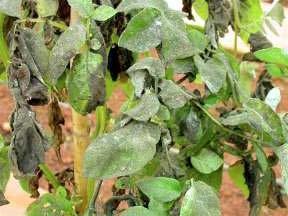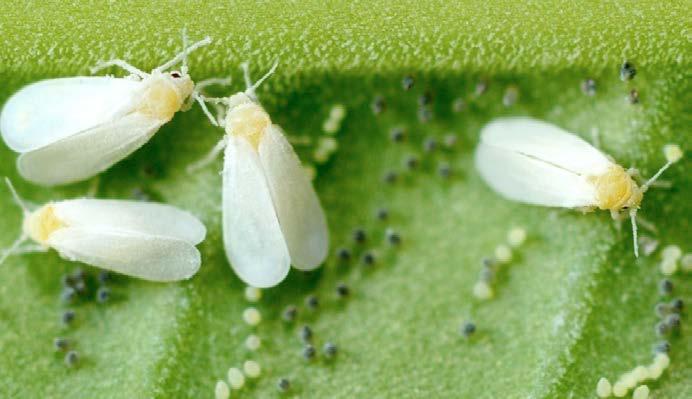
3 minute read
How Whitefly Pest Damages Greenhouse Tomato Crops
Figure 4. Sooty mould growing on tomato fruit. Approximately 300 pests are known to attack vegetables in South Africa. Most of these pests may damage crops wherever they are grown, but a few are especially damaging under protected environments. A few common greenhouse pests include aphids, thrips, leafminers, whiteflies and red spider mites. Of these, whiteflies, when the adults are present, are the most easily recognizable because of their habit to fly up in strikingly white swarms when disturbed.
Whiteflies are not flies, but tiny white insects belonging to the same insect order as aphids, i.e. Hemiptera. They occur world-wide, and are common pests of crops that are planted in protected environments. They have piercing-sucking mouthparts and, like aphids, suck the sap from plants. Whiteflies attack a variety of agricultural crops, including potato, tomato, sweet potato, legumes, cucurbits, crucifers, lettuce, tobacco, cotton, cassava and various other crops and weeds. Approximately 16 whitefly species occur in South Africa, of which two, the tobacco whitefly, Bemisia tabaci, and the greenhouse whitefly, Trialeurodes vaporariorum, are commonly found on vegetables in greenhouses. Whiteflies hide on the underside of leaves, and are usually only noticed when leaves are turned upside down. They have a milky-white appearance, and are approximately 1–2 mm in length (Fig. 1). Whitefly nymphs (larvae) are very different in appearance from the adults. They are wingless and translucent (Fig. 2 arrow) and become im-mobile after the first moult. Only the first instars (also called crawlers) are capable of moving around while searching for a feeding site on the
Advertisement

Figure 1. Whitefly adults on the underside of a potato leaf.
undersides of leaves. Because of their translucency, they take on the colour of the leaf and are not often noticed. The nymphs resemble flat scale insects, and on some crops, e.g. cucurbit leaves, they are nearly invisible to the naked eye. Whiteflies may damage crops in three different ways. Firstly by direct feeding (sucking plant sap), secondly, by acting as vectors of virus diseases, and thirdly by producing copious amounts of honeydew. The sucking action of whiteflies does not always damage plants. However, when plants are very small or when plants are under stress, direct feeding may cause wilting and eventually yellowing of leaves and dieoff. Up to 50% yield losses have been reported on some crops, directly linked to whitefly feeding. However, serious yield losses may occur when certain viruses, e.g. the tomato curly stunt virus (ToCSV) or Gemini-viruses, are present in the ecosystem. Whiteflies may transmit these viruses when moving between healthy and infected plants. Viruses cause mal-formed and chlorotic leaves, stunted growth and poor yield. Heavy yield losses are usually encountered when young plants are infected. Similarly to a few other sucking pests, e.g. aphids and mealy-bugs, whiteflies are notorious for their honeydew secretions. Honeydew is the sweet, sticky, excretions of plant-feeding hemipterans, usually secreted in such a way that it always lands on the upper leaf surfaces lower down from their feeding sites. Sooty mould (Fig. 3) may grow on the honeydew on the leaves, eventually killing individual leaves. Sometimes entire plants may be killed, e.g. the potato plant in Fig. 3. Sooty moulds are saprophytic black or brown fungi that grow superficially on leaf and fruit surfaces (Fig. 4), on which honeydew has accumulated. Sooty mould colonies may consist of mixed populations of eight or more different fungal species belonging to different families of the order Dothideales. It does not cause disease, but may downgrade the value of produce because the sticky brown/black powdery growth does not easily rub off. The black layer of fungal growth also prevents photosynthesis and therefore interferes with physiological processes of the affected plant. Whiteflies can be controlled with various insecticides. However, certain strains (or biotypes) of the tobacco whitefly exist that are more harmful and difficult to control. It is important to be aware of the nymph stage of this pest. Control measures should be implemented before the nymphs change into adult flies which move between plants and transmit viruses. Good insecticide coverage, especially
Figure 2. Whitefly adults with sedentary nymphs (white arrow).

Figure 3. Sooty mould growing on potato leaves.
on the undersides of leaves, is therefore necessary. Always read the insecticide label and use strictly according to label instructions. By: Dr Diedrich Visser; Crop Protection Division, ARC.










